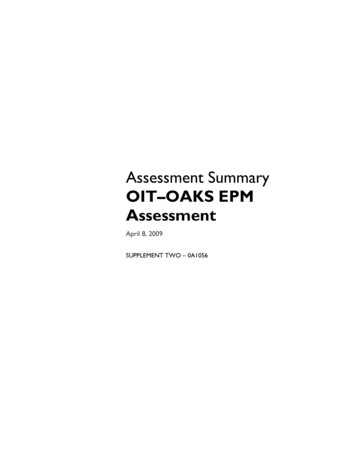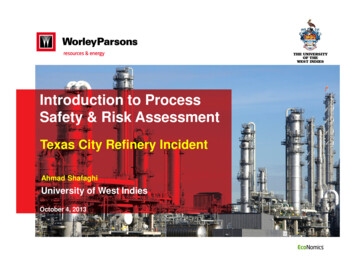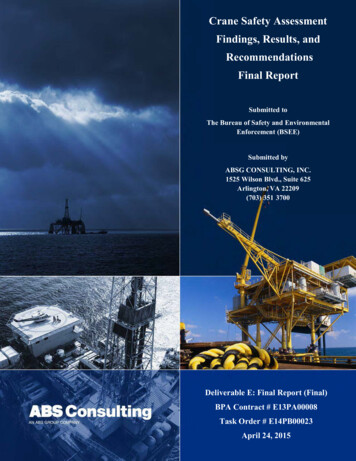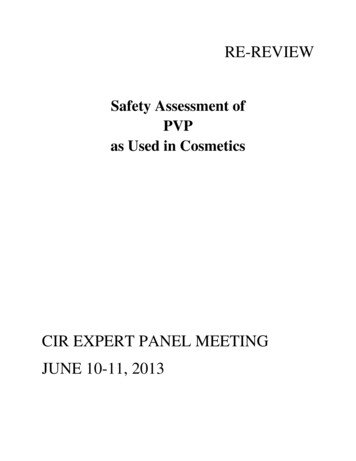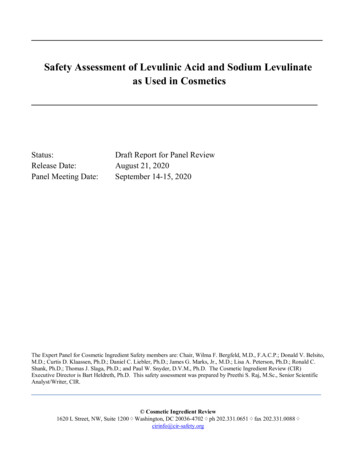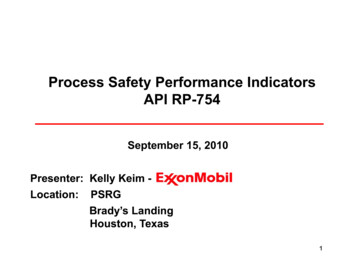Transcription
Safety Assessment of Polysilicone-11as Used in CosmeticsStatus:Release Date:Panel Meeting Date:Draft Tentative Report for Panel ReviewAugust 21, 2020September 14 – 15, 2020The Expert Panel for Cosmetic Ingredient Safety members are: Chair, Wilma F. Bergfeld, M.D., F.A.C.P.; Donald V. Belsito,M.D.; Curtis D. Klaassen, Ph.D.; Daniel C. Liebler, Ph.D.; James G. Marks, Jr., M.D.; Lisa A. Peterson, Ph.D.; Ronald C.Shank, Ph.D.; Thomas J. Slaga, Ph.D.; and Paul W. Snyder, D.V.M., Ph.D. The Cosmetic Ingredient Review (CIR)Executive Director is Bart Heldreth, Ph.D. This safety assessment was prepared by Priya Cherian, Scientific Analyst/Writer,CIR. Cosmetic Ingredient Review1620 L Street, NW, Suite 1200 Washington, DC 20036-4702 ph 202.331.0651 fax 202.331.0088 cirinfo@cir-safety.org
Distributed for Comment Only -- Do Not Cite or QuoteCommitment & Credibility since 1976MemorandumTo:Expert Panel for Cosmetic Ingredient Safety Members and LiaisonsFrom:Priya Cherian, Scientific Analyst/Writer, CIRDate:August 21, 2020Subject:Safety Assessment of Polysilicone-11 as Used in CosmeticsEnclosed is the Draft Tentative Report on the Safety Assessment of Polysilicone-11 as Used in Cosmetics(polysi092020rep). At the December 2019 meeting, the Panel issued an insufficient data announcement (IDA) for thisingredient. In order to determine the safety of this ingredient, the following data were requested: residual monomers and other reactants (e.g., polymerization initiators, chain propagators, terminators,solvents),molecular weight distributioncompositionimpurities28-day dermal toxicitymammalian genotoxicitysensitization/irritation data at maximum use concentration.Since the issuing of the IDA, the following unpublished data have been received, highlighted throughout the report, andincluded in this packet: Updated method of manufacturing and impurities information (polysi092020data1)Data on a cytotoxicity assay on a trade name mixture containing 12 – 16% Polysilicone-11, 43 – 50%dimethicone, and 36 – 42% cyclopentasiloxane (polysi092020data1)Summary HRIPT data on a trade name mixture containing 98% Polysilicone-11 and 2% laureth-12(polysi092020data2)Also included in this packet are updated 2020 VCRP data (polysi092020FDA) and corrected concentration of use data(polysi092020data3). Polysilicone-11 is now reported to be used in 440 total formulations (it was previously reported to beused in 420 total formulations). Corrected concentration of use data indicate that the maximum concentration of usereported for Polysilicone-11 is 19.9% in other skin care preparations. The previous maximum concentration of use wasreported to be 35% in face and neck preparations; the current maximum concentration of use for this category is reported tobe 14.6%.Other documents included in this package for your review are the CIR report history (polysi092020hist), flow chart(polysi092020flow), literature search strategy (polysi092020strat), ingredient data profile (polysi092020prof), minutes fromthe December 2019 meeting (polysi092020min), and addressed comments from Council on the Draft Report(polysi092020pcpc).After reviewing these documents, if the available data are deemed sufficient to make a determination of safety, the Panelshould issue a Tentative Report with a safe as used, safe with qualifications, or unsafe conclusion, and Discussion itemsshould be identified. If the available data are insufficient, the Panel should issue a Tentative Report with an insufficientdata conclusion.1620 L Street, NW Suite 1200, Washington, DC 20036(Main) 202-331-0651 (Fax) 202-331-0088(email) cirinfo@cir-safety.org (website) www.cir-safety.org
Distributed for Comment Only -- Do Not Cite or QuoteSAFETY ASSESSMENT FLOW ber 2020Public CommentCIRExpert PanelPriority ListINGREDIENTReport StatusPRIORITY LISTNotice to Proceedwithout an SLRJuly 2, 201960 day public comment periodDRAFT REPORTDec 2019Draft ReportTableTableIDAIDA NoticeDec 13, 2019Draft TRTRIDADRAFT TENTATIVEREPORTSept 2020TableTableIssue TRTentative ReportDraft FRDRAFT FINAL REPORT60 day Public comment periodTableTablePUBLISHFinal ReportDifferent ConclusionIssueFR
Distributed for Comment Only -- Do Not Cite or QuotePolysilicone-11 HistoryJuly 2019-A notice to proceed (NTP) was issued and the following data was requested: Chemistry information, including composition and structure, method of manufacture, and impuritydataToxicokinetics data relevant to routes of exposure expected with cosmetic useGeneral toxicity dataDevelopmental and reproductive toxicity dataGenotoxicity dataCarcinogenicity dataDermal irritation and sensitization dataInhalation toxicity dataAny other relevant safety information that may be available-The following unpublished data was received: HRIPTs on a leave-on product containing 9.675% Polysilicone-11 and a rinse-off product containing19.830% Polysilicone-11 was receivedSummary toxicity information received on various mixtures containing Polysilicone-11An in vitro tissue equivalent assay to evaluate the ocular irritation potential of a face creamcontaining 1.6% Polysilicone-11A human cumulative irritation patch test on a face cream containing 1.6% Polysilicone-11August 2019-The following unpublished data was received: General method of manufacturing informationA 48-hour patch test performed using a lipstick containing 1.8% Polysilicone-11A MatTek EpiOcularTM methyl thiazole tetrazolium (MTT) Viablity Assay on a test substancecontaining 98.5% Polysilicone-11A human dermal maximization assay performed to evaluate the contact-sensitization potential of aliquid blend containing 24.625% Polysilicone-11An HRIPT on a product containing 1.45% Polysilicone-11December 2019-Panel reviews the draft report and issues an IDA-Insufficiencies include: residual monomers and other reactants (e.g., polymerization initiators, chain propagators,terminators solvents), molecular weight distribution composition impurities 28-day dermal toxicity mammalian genotoxicity sensitization/irritation data at maximum use concentration.Data received from Council: impurities/method of manufacturing data received
Distributed for Comment Only -- Do Not Cite or Quote data on a cytotoxicity assay on a trade name mixture containing 12 – 16% Polysilicone-11, 43 – 50%dimethicone, and 36 – 42% cyclopentasiloxane-Council Comments on the Draft Report received-corrected information on concentration of use received (maximum concentration decreased to 19.9%)March 2020- HRIPT on a trade name mixture containing 98% Polysilicone-11 and 2% laureth-12 receivedSeptember 2020-Draft Tentative Report reviewed by Expert Panel
Distributed for Comment Only -- Do Not Cite or Quote* “X” indicates that data were available in a category for the ingredient1XCase nterIn rmalSensitizationIn VitroHumanDermalIrritationIn VitroOralCarciDermalIn VitroXIn se onImpuritiesXlog P/log KowMethod of MfgPolysilicone-11Reported UseToxicokinetics Acute ToxDermalPolysilicone-11 Data Profile – September 2020 – Priya Cherian, Scientific Analyst/Writer
Distributed for Comment Only -- Do Not Cite or Quote[Polysilicone-11]IngredientCAS #Polysilicone-11 63394-02-5156065-02-0InfoBYesPubMed arch Strategy[document search strategy used for SciFinder, PubMed, and Toxnet]Typical Search Terms INCI name CAS numbers chemical/technical names Key Words: dermal, irritation, sensitization, inhalation, metabolism, toxicityHPVIS NICNAS NTISNoNoNoNTPWHOFAONIOSHFEMAWebNoNoNoNoNoNo
Distributed for Comment Only -- Do Not Cite or QuoteTypical Search Terms INCI names CAS numbers chemical/technical names additional terms will be used as appropriateLINKSSearch Engines Pubmed (- http://www.ncbi.nlm.nih.gov/pubmed) Toxnet (https://toxnet.nlm.nih.gov/); (includes Toxline; HSDB; ChemIDPlus; DART; IRIS; CCRIS; CPDB; GENE-TOX) Scifinder (https://scifinder.cas.org/scifinder)appropriate qualifiers are used as necessarysearch results are reviewed to identify relevant documentsPertinent Websites wINCI - http://webdictionary.personalcarecouncil.org FDA databases http://www.ecfr.gov/cgi-bin/ECFR?page browseFDA search databases: y/ucm234631.htm;,EAFUS: ation.cfm?rpt eafuslisting&displayall trueGRAS listing: ng/gras/default.htmSCOGS database: ng/gras/scogs/ucm2006852.htmIndirect Food Additives: http://www.accessdata.fda.gov/scripts/fdcc/?set IndirectAdditivesDrug Approvals and Database: Offices/CDER/UCM135688.pdfFDA Orange Book: 9662.htmOTC ingredient list: 88.pdf(inactive ingredients approved for drugs: http://www.accessdata.fda.gov/scripts/cder/iig/ HPVIS (EPA High-Production Volume Info Systems) - https://ofmext.epa.gov/hpvis/HPVISlogonNIOSH (National Institute for Occupational Safety and Health) - http://www.cdc.gov/niosh/NTIS (National Technical Information Service) - http://www.ntis.gov/NTP (National Toxicology Program ) - http://ntp.niehs.nih.gov/Office of Dietary Supplements https://ods.od.nih.gov/FEMA (Flavor & Extract Manufacturers Association) - http://www.femaflavor.org/search/apachesolr search/ EU CosIng database: http://ec.europa.eu/growth/tools-databases/cosing/
Distributed for Comment Only -- Do Not Cite or Quote ECHA (European Chemicals Agency – REACH dossiers) – ssionid A978100B4E4CC39C78C93A851EB3E3C7.live1ECETOC (European Centre for Ecotoxicology and Toxicology of Chemicals) - http://www.ecetoc.orgEuropean Medicines Agency (EMA) - http://www.ema.europa.eu/ema/IUCLID (International Uniform Chemical Information Database) - https://iuclid6.echa.europa.eu/searchOECD SIDS (Organisation for Economic Co-operation and Development Screening Info Data Sets)- http://webnet.oecd.org/hpv/ui/Search.aspxSCCS (Scientific Committee for Consumer Safety) opinions: http://ec.europa.eu/health/scientific committees/consumer safety/opinions/index en.htmNICNAS (Australian National Industrial Chemical Notification and Assessment Scheme)- https://www.nicnas.gov.au/ International Programme on Chemical Safety http://www.inchem.org/FAO (Food and Agriculture Organization of the United Nations) - ific-advice/jecfa/jecfa-additives/en/WHO (World Health Organization) technical reports - http://www.who.int/biologicals/technical report series/en/ www.google.com - a general Google search should be performed for additional background information, to identify references that are available, and for other generalinformationBotanical Websites, if applicable Dr. Duke’s - https://phytochem.nal.usda.gov/phytochem/search Taxonomy database - http://www.ncbi.nlm.nih.gov/taxonomy GRIN (U.S. National Plant Germplasm System) - nomysimple.aspx Sigma Aldrich plant profiler- -research/learning-center/plant-profiler.html American Herbal Products Association Botanical Safety Handbook (database) - ook.aspx European Medicines Agency Herbal Medicines - http://www.ema.europa.eu/ema/index.jsp?curl pages/medicines/landing/herbal search.jsp National Agricultural Library NAL Catalog (AGRICOLA) https://agricola.nal.usda.gov/ The Seasoning and Spice Association List of Culinary Herbs and Spices http://www.seasoningandspice.org.uk/ssa/background culinary-herbs-spices.aspxFragrance Websites, if applicable IFRA (International Fragrance Association) – http://www.ifraorg.org/ Research Institute for Fragrance Materials (RIFM)
Distributed for Comment Only -- Do Not Cite or QuotePolysilicone-11 – CIR Expert Panel Meeting TranscriptsDECEMBER 2019 PANEL MEETING – INITIAL REVIEW/DRAFT REPORTBelsito Team – December 9, 2020DR. BELSITO: So, Polysilicone-11. Just looking at the points, it's the first time we're looking at it. Is everyone happy withthe method of manufacture and impurities? That's page 11.It says, "According to a supplier, Polysilicone-11 is manufactured in cosmetic grade cyclopentasiloxane solvent, preferablyfrom low cyclotrisiloxane, D4 feed stock using a hydrosilylation catalyst." Whatever that catalyst is.And then the impurities, less than 20 parts per million platinum catalyst, which I guess is the catalyst for hydrosilylation. Areyou happy with those?DR. LIEBLER: I’d like to see whether there are residual monomers.DR. BELSITO: Okay.DR. LIEBLER: And I think that the material from industry on page 58, indicates molecular weight greater than onemegadalton, very big molecules.So, that information should be cited in the physical chemical properties section, because that makes all the difference. Theseare not going to be absorbed because they're huge.DR. BELSITO: Okay. So then, that was my next question. Given size, are they insufficient for dermal absorption, and you'resaying we don't need dermal absorption?MR. LIEBLER: Don't need it.DR. BELSITO: So, you want to add in what, from where, Dan, to show their size?DR. LIEBLER: On Page 58, I think, there is a table or something. Let me look real quick. There is just a summary of dataprovided by industry, molecular weight greater than one million Dalton, i.e. one megadalton.DR. BELSITO: And bring that into physical properties?DR. LIEBLER: Correct. So once that's there, that pretty much nails it that these molecules are not going to be absorbed. So,we're really down to irritation and sensitization at that point. I don't know if you felt that the sensitization data were adequate?DR. BELSITO: Yes. Because they were pretreated with SLS.DR. LIEBLER: So, if you did then I felt like they were safe as used.DR. BELSITO: But you just said you want to know residual monomer.DR. SNYDER: Impurities, yeah.DR. LIEBLER: Yeah, once the impurities. Can be addressed. I just meant that's where I see this heading.DR. BELSITO: Okay. Well, I was going even beyond that. Okay. So basically, we need insufficient for residual monomer.DR. LIEBLER: You know what, if these are clean, with safety data in skin tests, then we don't need to ask about residualmonomers.DR. SNYDER: Well, we do have lipstick use at 8.8 percent and sprays at 0.04 percent, so maybe we probably should have it,I think.DR. LIEBLER: Well, if -- and if the sensitization data -DR. BELSITO: This is the first time we're looking at it. We can ask for the data and decide later. So, insufficient for residualmonomer.DR. LIEBLER: Okay.DR. BELSITO: Okay, now you can go to lunch. That's one way of moving through a chemical fast is to threaten holdinglunch, right? Yeah, we have honey for lunch.Marks Team – December 9, 2020DR. MARKS: Priya, you’re up again, huh? So this is a draft report of polysillicone-11. This is the first review of the singleagent. It’s a reaction -- chemical reaction between vinyl dimethicone and hydrogen methicone, which the panel previouslyevaluated and found both of them to be safe. So, Ron, Tom, needs? What should we move for?
Distributed for Comment Only -- Do Not Cite or QuotePolysilicone-11 – CIR Expert Panel Meeting TranscriptsDR. SHANK: I have insufficient for more chemical properties. It says the test agent was a molecular weight of greater thanthe million, if that’s typical of the cosmetic ingredient. And I had a question -- I’m not sure what was tested -- what wasmentioned was the cosmetic ingredient.But if it isn’t molecular weight of over a million, then I don’t think it’s likely it would cross the skin. So, systemic toxicity dataare not needed. But the skin sensitization data were below a maximum concentration of use. So, I thought perhaps we neededmore skin sensitization data done at the maximum use concentration.DR. MARKS: Yeah. So, the human maximization assay was at 25 percent, and the maximum use concentration’s up to 35percent. So for sure, get a sensitization, preferably HRIPT at 35 percent. Yeah, even though, as you say, the molecular weight,if it is -- was that under the chemistry section of molecular weight over a million?DR. SHANK: Page 58.DR. MARKS: Page 58. Okay. Now, if that’s accurate, which is hard to believe, probably it’s not going to sensitize either,it’s not going to get through. But we’ll ask for that. We’ll be seconding. Tom, your input?DR. SLAGA: Well, I agree with Ron, insufficient in terms of, I had that there was bacterial genotox, but there wasn’t anymammalian. I’m not sure we really need it because of the size. But it’s the first time, I wouldn’t mind seeing it.I always love to see a 28-day dermal, just because it gives a lot of data to help support potential or give you an idea if theremay be some alert for carcinogenic activity.But once again, I don’t have any concerns. It’s nice data to have, so therefore, I’d like to see it.DR. MARKS: Okay.DR. SHANK: I agree, if the molecular weight’s over a million -DR. SLAGA: We probably don’t need it.DR. SHANK: I don’t think we need genotox or developmental, reproductive, 28-day.DR. ANSELL: Or sensitization. I could see an irritation, a direct effect. But if, in fact, it’s over a million, any type ofsystemic driven endpoints are, I think, off the table. So, I would question whether we really do need to go up from 25 to 32percent.DR. HELDRETH: Yeah. In addition to -- if we have confidence that this is the molecular weight to expect when thisingredient was used, remember also that this ingredient is cross-linked. So, we’re not talking about a thin, linear change.We’re talking about probably a very large lattice network. So not only is there high molecular weight, there’s probably verylarge molecular volume.DR. ANSELL: In essence, a single molecule.DR. SLAGA: I don’t have any concern it’d get through to skin, but things still can have effect on the skin, right?DR. MARKS: Oh, absolutely. So, the two building blocks in this were both felt to be safe. Is that reassuring? Do we need tomolecular weight? Because the question would be, is the question are there smaller -- is it smaller than a molecular weightover a million? That’s what you found in your -- Priya, when you did the research, the molecular weight was defined as over amillion?MS. CHERIAN: It came in a data supplement.DR. HELDRETH: Yeah. It was in unpublished data that was submitted to us anonymously. I mean, theoretically, you couldmake these polymers practically any size. They could vary from being a liquid to being a very hard rubbery material.But the only information we have that directly points to use as an ingredient demonstrates a molecular weight this high.DR. MARKS: So really, we get back to -- I guess, and then how much of the monomer would be present, and would it getthrough.DR. PETERSON: That was my question. Whenever you have a polymer, there might be some leftovers at the beginningpart.DR. MARKS: So, it could be as you said, Ron Shank, to begin with, define the chemical. I guess one could also put in thereas a molecular weight of a million and how much of a monomer is left. Of course, are we really worried about the monomer?I guess we really don’t know that unless we have the data.DR. ANSELL: Just as a point of reference, it’s not a million, it’s in excess of a million. It’s actually not measurable.DR. PETERSON: Polymers are hard to measure. Yeah. Molecular weight on it.DR. HELDRETH: Particularly cross-linked. page
Aug 21, 2020 · DR. LIEBLER: I’d like to see whether there are residual monomers. DR. BELSITO: Okay. DR. LIEBLER: And I think that the material from industry on page 58, indicates molecula

